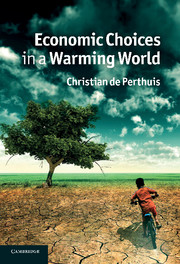Book contents
- Frontmatter
- Contents
- Acknowledgements
- Introduction
- 1 Climate risk
- 2 Some like it hot: adaptation to climate change
- 3 Building a low-carbon energy future
- 4 Pricing carbon: the economics of cap-and-trade
- 5 Intensifying agriculture to safeguard forests
- 6 The price of carbon: the economics of projects
- 7 Macroeconomic impacts: sharing carbon rent
- 8 International climate negotiations
- Conclusion
- References
- Appendix 1 Thirty key readings
- Appendix 2 Thirty key sets of figures
- Appendix 3 Greenhouse gas emissions around the world
- Glossary
- Index
Appendix 2 - Thirty key sets of figures
Published online by Cambridge University Press: 05 June 2012
- Frontmatter
- Contents
- Acknowledgements
- Introduction
- 1 Climate risk
- 2 Some like it hot: adaptation to climate change
- 3 Building a low-carbon energy future
- 4 Pricing carbon: the economics of cap-and-trade
- 5 Intensifying agriculture to safeguard forests
- 6 The price of carbon: the economics of projects
- 7 Macroeconomic impacts: sharing carbon rent
- 8 International climate negotiations
- Conclusion
- References
- Appendix 1 Thirty key readings
- Appendix 2 Thirty key sets of figures
- Appendix 3 Greenhouse gas emissions around the world
- Glossary
- Index
Summary
The atmosphere and greenhouse gases
The atmosphere is a thin layer of gas that becomes denser nearer to the ground. When we travel by air (at an altitude of 10 kilometres), around 70 per cent of the molecules comprising it, including greenhouse gases, are below us. At an altitude of 50 kilometres, one has passed through the ozone layer. Beyond that, the atmosphere gives way to empty space.
The Earth's atmosphere consists largely of nitrogen (78 per cent) and oxygen (21 per cent). Greenhouse gases (excluding water vapour) account for less than 0.04 per cent of the total. These percentages of the total volume exclude water vapour, the concentration of which (0–4 per cent) depends to a great extent on weather conditions.
The various greenhouse gases do not remain indefinitely in the atmosphere. But how long each gas stays there varies. A molecule of methane remains in the atmosphere for twelve years on average, a molecule of nitrous oxide 114 years, and industrial gases from hundreds up to thousands of years. Due to its very complex cycle, carbon dioxide (CO2) can remain there between two years and several thousand years.
[…]
- Type
- Chapter
- Information
- Economic Choices in a Warming World , pp. 231 - 236Publisher: Cambridge University PressPrint publication year: 2011



